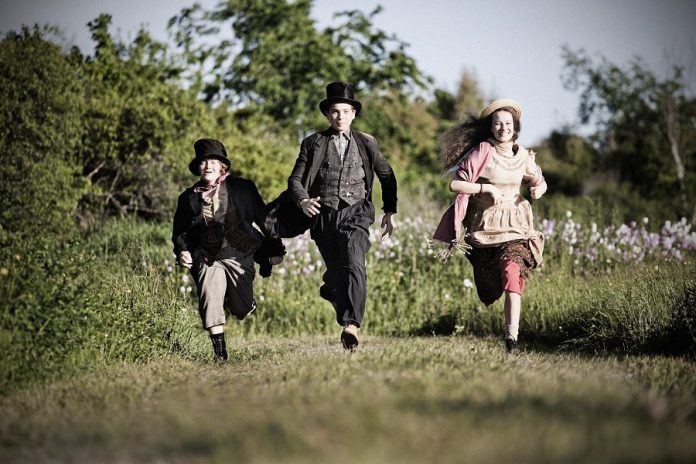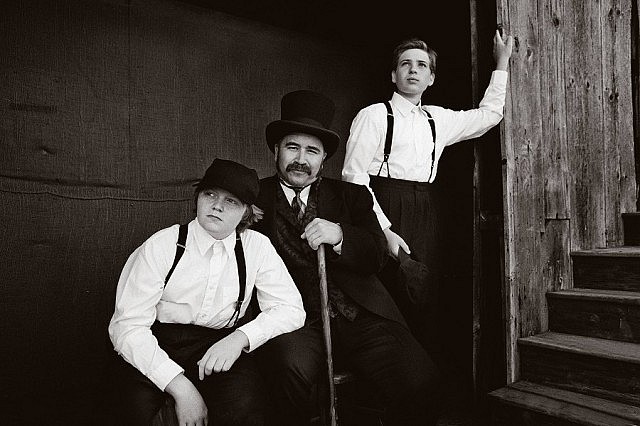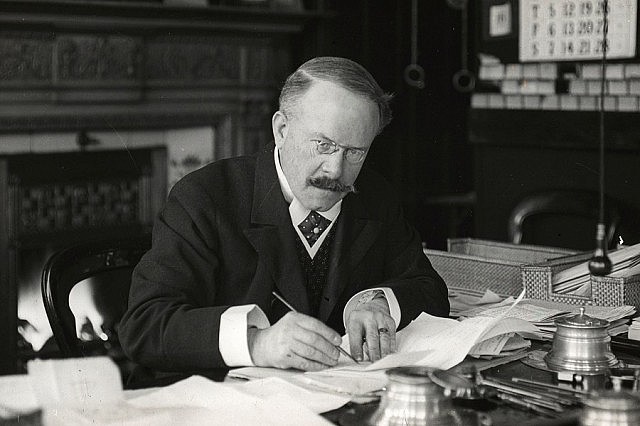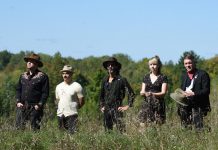
With dark clouds looming above and a refreshing breeze ripping through a packed house, 4th Line Theatre opened its 23rd season on July 3rd with a revival of Rob Winslow and Ian McLauchlan’s Doctor Barnardo’s Children. Thankfully, the rain held off and the performance was not interrupted. Instead, the only rumble of thunder was the one created by the audience’s standing ovation at the conclusion of the show.
Famous across Canada for their unique theatre space, excellence in original productions, and interesting and often untold stories from the Peterborough area, Rob Winslow and his company have created another triumph, assuring another successful season for 4th Line Theatre.
One of the Winslow Farm’s most celebrated productions, Doctor Barnardo’s Children was originally presented in 2005 and 2006. An engaging and powerful historical piece, the play chronicles the true-life stories and experiences of the thousands of orphaned and poverty-stricken children who were taken off the streets of London England and sent to Canada between 1870 and 1930 by philanthropist Dr. Thomas John Barnardo. One of Barnardo’s homes (Hazelbrae) was located in Peterborough, through which approximately 9,000 girls moved from 1884 to 1923. While many of the Barnardo girls were trained to become domestic workers, boys were sent to work as farm labourers.
While Dr. Barnardo had moral and just intentions in taking children off the street and giving them a better life, the scope of his vision was often too great and, as a result, flawed. Families were ripped apart and children often were subject to harsh discipline and abuse at the hands of their caretakers. Based on real-life testimonies given to the playwrights by surviving Barnardo children, the stories of these displaced children was once a lost piece of history. However, due to the growing popularity and captivating presentation of this powerful production — as well as the efforts of Barnardo organizations across Canada — the stories of this generation of immigrant orphans are now being told.

A third element to the production is the larger-than-life presence of Doctor Barnardo himself, who narrates his own story, vision, and philosophy as he takes the audience through the history of his lifelong dedication to working with impoverished children.
Directing a large disciplined cast (the majority being young actors), Rob Winslow knows how to get actors to create the desired story and emotion that he wants. With a large open field and outdoor space as the stage, his actors need to project louder than usual, while still striking an emotional chord to be felt by the audience.
Although a dramatic piece with comedic points and moments of joy, the drama in Doctor Barnardo’s Children is often filled with tragedy, darkness, and disturbing themes. However, the constant human element, with the honest emotions brought to the forefront by the primary characters, keeps the audience engaged. It’s impossible not to become emotionally involved with the characters, especially with Walter’s search for Lily.
One of the unique elements of Doctor Barnardo’s Children is the range of generations of the actors. From small children in their first acting roles to seasoned actors who’ve been working in theatre for decades, it’s a large cast with each performer bringing his or her unique energy to the performance space. This is no more evident in the casting of two sets of Billys and Walters: Gary Bryant and Geoff Hewittson as senior Walter and Billy, and Justin Laurie and Liam Davidson as young Walter and Billy. Although it takes a full cast of performers to create the world of Dr. Barnardo, both past and present, these four actors carry the majority of the drama on their shoulders.
Playing the central character in the production, Bryant and Laurie show the different faces of Walter during different eras of his life but are able to maintain continuity in character — making it easily believable that both actors are playing the same character. Bryant’s Walter is often gruff, stand-offish, and emotionally damaged with moments of anger, while Laurie’s Walter is strong, brash, and bold. Both actors also show a soft sensitive side when it comes to their longing for their lost sister and the trauma of their past and present situation. Walter White is the audience’s anchor, giving the production a hero for people to care about.
Meanwhile, Billy Fiddler is the charismatic sidekick who often acts as the comic relief to the broodier Walter. With a strong verbal flair, Hewittson plays Billy as talkative, if not slightly eccentric. He has a twinkle in his eye through various monologues about the experiences of being a Barnardo child. However, despite his whimsical nature, Hewittson gives many of the most dramatic monologues, often acting as the voice of reason in the show, and giving some of the bluntest descriptions of the reality of the Barnardo children.
But it is 12-year-old Liam Davidson who gives the stand-out performance as the young Billy. With a bounty of energy and enthusiasm, Davidson steals every scene he’s in. From comic timing to physical performance (as expertly displaced in a scene depicting the children crossing the Atlantic) to dramatic moments, Davidson is filled with endless energy and dramatic flair. Davidson is an exceptional young actor with great potential to have a big career in theatre.
Although her part is smaller than that of the male actors, Francis Loiselle gives a moving performance as Walter’s sister Lily. A role that is mixed with sweetness and darkness, Loiselle takes on many faces and emotions in her performance, creating some of the most potent moments of the show.
Gelling the production all together is Herbie Barnes as Doctor Thomas Barnardo. Charismatic and larger than life, Barnes creates the role of an idealistic and moral man who truly believes in what he is doing. However, as his philanthropy grows larger and falls out of his hands in the second act of the production, Barnes shows various conflicting emotions as his character begins to see the flaws in his own organization and realizes that he cannot protect or save every child. A terrific performance from an engaging actor.

There’s little wonder why 4th Line Theatre has earned a world-renowned reputation, as the entire theatre experience is first class. From its excellent staff and press agents to its powerful dramas and incredible talented company of players (too many to mention here), 4th Line Theatre has lived up to its reputation once again. Not only is Doctor Barnardo’s Children a production that should be seen by both theatre regulars as well as anybody interested in the history of Peterborough, a visit to the Winslow Farm is a wonderful experience and needs to be a destination on everybody’s map. And if anybody needs another excuse to make it back out to the farm, in August Rob Winslow will be debuting the second chapter of Walter White and Billy Fiddler’s story in Wounded Soldiers, a sequel to Doctor Barnardo’s Children.
By far one of the best theatre experiences that this community has to offer, Doctor Barnardo’s Children runs every Tuesday to Saturday until July 26th, with an additional performance on Monday, July 21st. All shows start at 6 pm and tickets are $35 ($29.50 for youth under 17).


























